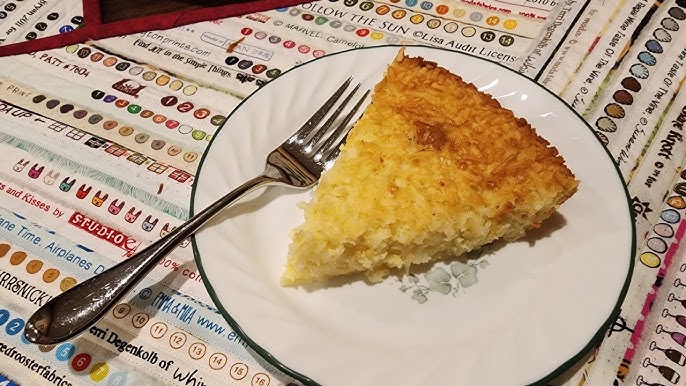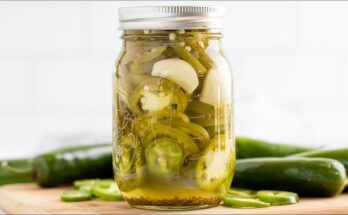Coconut Custard Pie Recipe: There’s something incredibly comforting about a homemade coconut custard pie. It’s creamy, rich, and packed with tropical flavor that takes you straight to a beachside paradise. Whether you’re making it for a holiday dinner or just because you have a craving, this classic dessert always hits the spot. Unlike coconut cream pie, which uses a pudding-like filling, coconut custard pie is baked with eggs, creating a firmer, silky texture that’s pure indulgence. If you’re a coconut lover, you’re going to fall head over heels for this one.
Ingredients You’ll Need
Let’s talk ingredients—fresh, quality ingredients are key to making a pie that truly stands out. Here’s everything you’ll need:
For the Pie Filling
- 4 large eggs
- 1 cup granulated sugar
- 2 cups whole milk (or half-and-half for extra creaminess)
- 1 teaspoon pure vanilla extract
- ½ teaspoon ground nutmeg
- ¼ teaspoon salt
- 1½ cups sweetened shredded coconut
For the Pie Crust
- 1 9-inch unbaked pie shell (store-bought or homemade)
- Optional: 1 tablespoon melted butter for brushing
You can go for a flaky homemade crust if you want a rustic, from-scratch touch, or keep it simple with a store-bought one. Either way, the filling will shine.
Tools and Equipment Required
Before diving in, make sure your kitchen is prepped with these essentials:
- Mixing bowls
- Whisk
- Measuring cups and spoons
- Pie dish (9-inch)
- Oven
- Cooling rack
- Aluminum foil or pie shield (to prevent crust over-browning)
Having everything ready before you start will make the process smooth and enjoyable.
Step-by-Step Instructions
Let’s get baking! Follow these easy steps for the perfect coconut custard pie.
Step 1: Preheat and Prep
First things first—preheat your oven to 350°F (175°C). If you’re using a store-bought crust, place it in your pie dish and set it aside. For homemade crusts, make sure it’s rolled out evenly, fitted into your pie dish, and crimped around the edges. You don’t need to pre-bake the crust for this recipe.
Step 2: Making the Custard Mixture
In a large bowl, crack in your eggs and whisk them until smooth and pale yellow. Gradually add sugar, continuing to whisk until the mixture is light and fluffy. Slowly pour in the milk, followed by the vanilla extract, nutmeg, and salt. Once everything is well combined, fold in the shredded coconut. The batter should be rich and slightly thick, with coconut well dispersed throughout.
Tip: Use room-temperature eggs and milk for a smoother, better-mixed custard.
Step 3: Preparing the Crust
If you’re brushing your crust with melted butter, now’s the time. This simple step gives the edges a golden, glossy finish after baking. Place your pie crust on a baking sheet—this helps catch any potential spills in the oven and makes it easier to handle.
Step 4: Assembling the Pie
Pour the custard mixture into your pie crust, using a spatula to even out the surface and ensure coconut is distributed evenly. Don’t overfill—leave a bit of space at the top to prevent overflow during baking.
Optional: Sprinkle a pinch of nutmeg or a bit more shredded coconut on top for extra flair.
Step 5: Baking the Pie
Carefully transfer the pie to the oven and bake for 45 to 55 minutes, or until the center is set and no longer jiggles when lightly shaken. If the crust edges start browning too quickly, cover them with foil or a pie shield.
Once done, remove the pie and let it cool completely on a wire rack. The custard will continue to firm up as it cools.
Cooling and Serving
Patience is key here—don’t rush it! The pie needs to cool fully to get that perfect custard texture. After cooling, you can refrigerate it for at least 2 hours to make it easier to slice. Serve it chilled or at room temperature, with a dollop of whipped cream or a sprinkle of toasted coconut for extra decadence.
Storage and Make-Ahead Tips
- Refrigeration: Store leftover pie in an airtight container or wrapped in plastic wrap. It stays fresh in the fridge for up to 4 days.
- Freezing: Coconut custard pie can be frozen (wrapped tightly) for up to a month. Thaw in the fridge before serving.
- Make-Ahead: You can make the pie a day in advance, letting the flavors meld overnight. It tastes even better the next day!
Common Mistakes to Avoid
- Overbaking: This will dry out the custard. Watch for that slight jiggle in the center—it means it’s done.
- Cold Ingredients: Room-temperature eggs and milk mix more smoothly and bake more evenly.
- Skipping the cooling time: Custard needs time to set. Cutting too early will give you a runny mess.
FAQs about Coconut Custard Pie Recipe
1. Can I use unsweetened coconut instead of sweetened?
Yes, but you might want to add a bit more sugar to balance the sweetness.
2. What’s the difference between coconut custard pie and coconut cream pie?
Coconut custard pie is baked with eggs, creating a firmer filling. Coconut cream pie uses a stovetop custard and is not baked.
3. Can I use coconut milk instead of whole milk?
You can, but it may change the texture and make it slightly denser.
4. Is this pie gluten-free?
Only if you use a gluten-free pie crust.
5. How do I know when the pie is fully baked?
The edges will be firm, and the center should have a slight jiggle but not be liquidy.
Final Thoughts
There you have it—a full-proof, easy-to-follow guide to making the perfect coconut custard pie. It’s a dessert that brings comfort and joy with every bite. Whether you’re a seasoned baker or a beginner in the kitchen, this recipe will become a go-to favorite. The creamy coconut custard, the buttery crust, and that nostalgic homemade feel—it’s all the magic you need in a pie. Give it a try, and share the love with friends and family.



